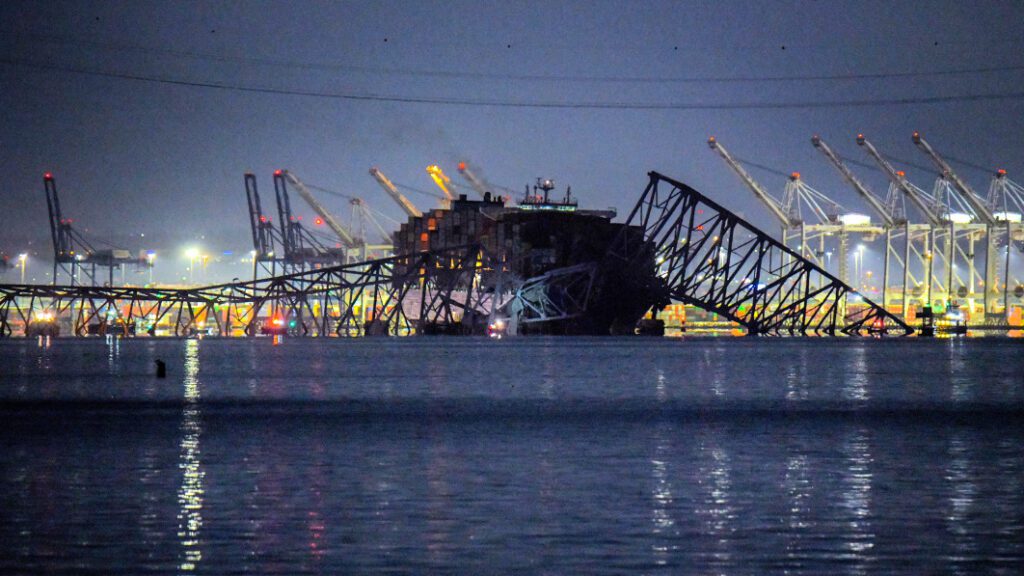Baltimore bridge collapse: Who was steering the ship, how many people are missing?

BALTIMORE — A cargo ship rammed into Baltimore’s Francis Scott Bridge early Tuesday, causing the span to collapse and rescuers to launch a massive search for at least six people who are missing.
Here’s what we know so far about the disaster:
What exactly happened?
The operators of the Dali cargo ship issued a mayday call that the vessel had lost power moments before the crash, Maryland Gov. Wes Moore said. But he said the ship was still barreling toward the span at “a very, very rapid speed.”
The 985-foot (300-meter) long vessel struck one of the 1.6-mile (2.6-kilometer) bridge’s supports, causing the span to break and drop into the water within seconds. The ship caught fire, and thick, black smoke billowed out of it.
Synergy Marine Group, which manages the ship, said it was in the control of one or more pilots, who are local specialists who help navigate vessels safely into ports.
The ship was moving at 8 knots, which is roughly 9 mph (15 kph), when it struck the span, the governor said.
Federal inspectors rated the 47-year-old bridge to be in fair condition last June. But the structure did not appear to have pier protection to withstand the crash, experts said.
“If a bridge pier without adequate protection is hit by a ship of this size, there is very little that the bridge could do,” according to Virginia Tech engineering professor Roberto Leon.
How many people are missing?
Two people were rescued, but officials said six people were still unaccounted for as of late morning. All were believed to be part of a construction crew that was repairing potholes on the bridge.
Sonar had detected cars in the water, which is about 50 feet (15 meters) deep. The water temperature was about 47 degrees Fahrenheit (8 degrees Celsius) before dawn Tuesday, according to a buoy that collects data for the National Oceanic and Atmospheric Administration.
Kevin Cartwright, director of communications for the Baltimore Fire Department, told The Associated Press that several vehicles were on the bridge at the time of the collapse, including one the size of a tractor-trailer. He called the collapse a “developing mass casualty event,” though he didn’t know how many people were affected.
The ship is owned by Singapore-based Grace Ocean Private Ltd., which said all crew members, including the two pilots, were accounted for and there were no reports of injuries involving anyone who was on board.
The ship’s warning enabled authorities to limit vehicle traffic on the span. Plus, the accident occurred at 1:30 a.m., long before the busy morning rush. The bridge carried an estimated 30,800 vehicles a day on average in 2019.
What impact could this have?
All ship traffic into and out of the Port of Baltimore has been suspended until further notice, though the port remains open to trucks, Maryland Transportation Secretary Paul Wiedefeld said.
Last year, the port handled a record 52.3 million tons of foreign cargo worth $80 billion, according to the state. In addition to cargo, more than than 444,000 passengers cruised out of the port in 2023.
The port is a major East Coast hub for shipping. The bridge spans the Patapsco River, which massive cargo ships use to reach the Chesapeake Bay and then the Atlantic Ocean.
The Dali was headed from Baltimore to Colombo, Sri Lanka, and flying under a Singapore flag, according to data from Marine Traffic.
President Joe Biden said Tuesday that he plans to travel to Baltimore “as quickly as I can” and that he expects the federal government to pick up the entire cost of rebuilding the bridge.
How often does this happen?
From 1960 to 2015, there were 35 major bridge collapses worldwide due to ship or barge collisions, with a total of 342 people killed, according to a 2018 report from the World Association for Waterborne Transport Infrastructure.
Eighteen of those collapses happened in the United States.
Among them were a 2002 incident in which a barge struck the Interstate 40 bridge over the Arkansas River at Webbers Falls, Oklahoma, sending vehicles plunging into the water. Fourteen people died and 11 were injured.
In 2001, a tugboat and barge struck the Queen Isabella Causeway in Port Isabel, Texas, causing a section of the bridge to tumble 80 feet (24 meters) into the bay below. Eight people were killed.
In 1993, barges being pushed by a towboat in dense fog hit and displaced the Big Bayou Canot railroad bridge near Mobile, Alabama. Minutes later, an Amtrak train with 220 people on board reached the displaced bridge and derailed, killing 47 people and injuring 103 others.



